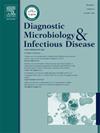Candida tropicalis in the diabetic urinary tract: Biofilm resistance, genomic plasticity, and public health implications
IF 2.1
4区 医学
Q3 INFECTIOUS DISEASES
Diagnostic microbiology and infectious disease
Pub Date : 2025-07-11
DOI:10.1016/j.diagmicrobio.2025.117005
引用次数: 0
Abstract
Fungal urinary tract infections (fUTIs) are emerging as a public health concern, notably in South Asia, where a convergence of ecological, genetic, and clinical factors underlies a rising burden of antifungal-resistant disease. This review synthesizes epidemiological, mechanistic, and genetic evidence implicating Candida tropicalis as a dominant uropathogen in South Asia’s diabetic and immunocompromised populations. We examine the shift from Candida albicans to non-albicans Candida (NAC) species, driven by selective antifungal pressure and nosocomial transmission. Emphasis is placed on the virulence and adaptability of C. tropicalis, which forms biofilms, adapts metabolically under glycosuric and hypoxic conditions, and expresses antifungal resistance genes such as ERG11, CDR1, MDR1, and FKS1. Concurrently, South Asian host populations exhibit genetic variants—e.g., in TLR4, CLEC7A, CYP2C19—that impair fungal recognition, immune clearance, and antifungal pharmacokinetics, creating a syndemic landscape. We detail biofilm-mediated resistance mechanisms, epigenetic regulation of virulence genes, and the role of environmental sensing pathways in adaptive pathogenesis. Furthermore, the review delineates clinical challenges posed by biofilm-associated infections, delayed diagnostics, and resistance underestimation. Finally, we propose a suite of public health and clinical recommendations—including biofilm-specific diagnostics, antifungal stewardship programs, pharmacogenomic screening, and national surveillance—to mitigate the escalating burden of drug-resistant candiduria. This integrative perspective bridges molecular pathogenesis and systems-level responses, offering a strategic roadmap for clinicians and policymakers to address C. tropicalis-driven fUTIs in South Asia and other high-risk regions.
热带假丝酵母在糖尿病尿路:生物膜耐药性,基因组可塑性,和公共卫生意义
真菌性尿路感染(fUTIs)正在成为一个公共卫生问题,特别是在南亚,在那里,生态、遗传和临床因素的融合导致抗真菌耐药性疾病的负担日益增加。这篇综述综合了流行病学、机制和遗传学证据,表明热带念珠菌是南亚糖尿病和免疫功能低下人群的主要泌尿病原体。我们研究了由选择性抗真菌压力和医院传播驱动的白色念珠菌向非白色念珠菌(NAC)物种的转变。重点研究了C. tropical alis的毒力和适应性,其形成生物膜,在糖酸和缺氧条件下进行代谢适应,并表达抗真菌抗性基因,如ERG11、CDR1、MDR1和FKS1。同时,南亚寄主种群表现出遗传变异,例如:在TLR4、CLEC7A、cyp2c19中,它们会损害真菌识别、免疫清除和抗真菌药代动力学,从而形成综合征景观。我们详细介绍了生物膜介导的抗性机制,毒力基因的表观遗传调控,以及环境感知途径在适应性发病机制中的作用。此外,该综述描述了生物膜相关感染、延迟诊断和耐药性低估所带来的临床挑战。最后,我们提出了一套公共卫生和临床建议,包括生物膜特异性诊断、抗真菌管理计划、药物基因组学筛查和国家监测,以减轻耐药念珠菌不断增加的负担。这一综合视角连接了分子发病机制和系统级反应,为临床医生和政策制定者提供了战略路线图,以应对南亚和其他高风险地区由热带梭菌引起的fUTIs。
本文章由计算机程序翻译,如有差异,请以英文原文为准。
求助全文
约1分钟内获得全文
求助全文
来源期刊
CiteScore
5.30
自引率
3.40%
发文量
149
审稿时长
56 days
期刊介绍:
Diagnostic Microbiology and Infectious Disease keeps you informed of the latest developments in clinical microbiology and the diagnosis and treatment of infectious diseases. Packed with rigorously peer-reviewed articles and studies in bacteriology, immunology, immunoserology, infectious diseases, mycology, parasitology, and virology, the journal examines new procedures, unusual cases, controversial issues, and important new literature. Diagnostic Microbiology and Infectious Disease distinguished independent editorial board, consisting of experts from many medical specialties, ensures you extensive and authoritative coverage.

 求助内容:
求助内容: 应助结果提醒方式:
应助结果提醒方式:


